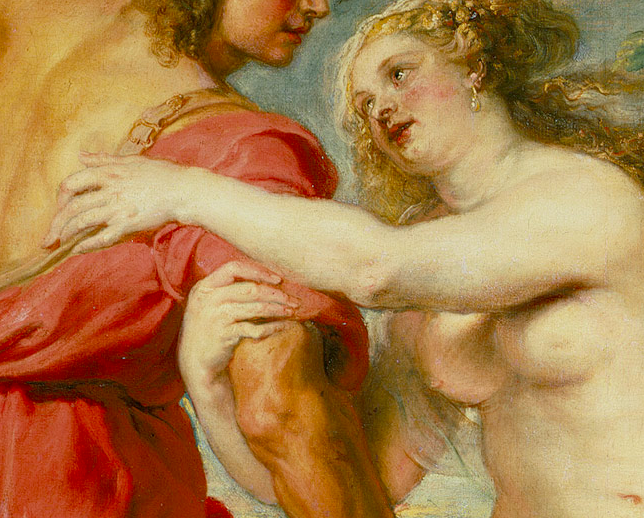Edinburgh. It’s my third day here, a return to Scotland after 18 years away.
My readings at the book festival are done, and all I want now is a few hours in the National Gallery, which has a strong collection of paintings. I went for half an hour yesterday. Now to go in and spend more time.
I think if I ever went blind—I wrote an essay on the subject last week, and I’m still preoccupied with it—I would miss looking at paintings even more than I’d miss taking photographs. I follow this thought, and I’m surprised at where it leads. I realize that the artist whose work I’d most miss seeing is Rubens.
Why should this be so? He’s not my favorite painter, an honor that belongs either to Caravaggio or Titian. He’s not even one of my ten favorites: Degas, Bruegel, Vermeer, de Kooning, Picasso, and Velázquez all have greater claims on my enthusiasm. In fact he’s not even my favorite painter in his own studio: that would be van Dyck, a genius by his late teens, who, in my view, readily surpasses his master.
So what's going on. Why the soft spot for Rubens? What’s with this sentimentally towards Mr Tries-too-hard? I think part of it is that I’m understanding more and more his command of the material of painting. His colors–the unexpected rose, the unanticipated ashy-blues–his variety of brush strokes, his combination of meticulousness with hurry, even his ability to compel drama out of dry classical texts. Taken as a whole, he is not as satisfying as many other old masters, but on the level of the square inch, he is as interesting as anyone who ever put paint to canvas. He is to the eye what a test record is to the record player: a reminder of the range of possibilities present. He's a running track for the optic nerve, putting it through its paces.
There’s so much to Rubens, so much acreage of his hectic and indefatigable work, and all of it, at the microlevel, is a testimony to the varieties of seeing. There are no unnecessary shadows anywhere in his work, no obfuscation (in this he's not dissimilar to de Kooning). He is always eager to show what he can do and to let it be seen. He takes Titian’s hard won freedom and deploys it as though such freedom were the most natural thing in the world, that the natural will of painting is to be free in flesh and sky and fur and field. The 1630s copy he made of Titian’s Venus and Adonis is a good case in point. Looser, freer, not better (how could it be?) but, mysteriously, not worse either; Titian's greatness transposed to the Rubenesque.
I can remember a good Caravaggio, and remember more or less how it does what it does. Its details are crisp, literally impressive. I can remember a good Sargent, a good Matisse, even a good Pollock or Mehretu. But, somehow, a good Rubens, what makes a good Rubens good, is hard to pin into memory. Hence the eye’s hunger for him: I make repeated visits to the Met, I seek him out in foreign museums. His is a reliable ocular wealth, a luxury sure as sure can be, impious, fancy, reassuringly strange to twenty-first century eyes.
The subject matter is there, sure, though there’s always something awkward in his deployment of it, an awkwardness missing from Van Dyck; an awkwardness that always trembles on the edge of ugliness. We can, with effort, remember the subject matter (though there's an intimidating lot of it, and Rubens bests Dürer as the most learned of all artists). But it is just about impossible to remember how the brown fur is depicted here, how the sensual fat-dimpled skin of a thigh is made true there, how the small faint green of a neck vein is evoked further along, how the russet of an evening sky is scumbled across the weave of one corner of the enormous canvas.
This is not so much a question of loose brush technique as it is about the intensity of styles he employs within any given patch of a painting. The colors are ardent, but they are also wide-spectrum: how limited his fellow classics fanatic, Poussin, seems in this regard, with his stolid yellows, reds, and blues. When I’m looking at a Rubens, I’m looking at a hundred colors I can’t name, a language in which the eye lords it over speech. The arm of Venus, the arm of Adonis, the cloak of Adonis, the hair of Venus: the colors and textures succeed each other fast, and the inability to commit all this to memory is a matter of the brain’s native limits. It is always in need of renewal by the eye. And neither prints nor scans are any good for this purpose: only visits to galleries or to billionaire aunts will do.
A Poussin is a poem. A Titian is a poem. Even a Rembrandt, in its rough-hewn way, is a poem. A Rubens, small or large, is a compendium. A poem can be learned by heart, an encyclopedia never.
